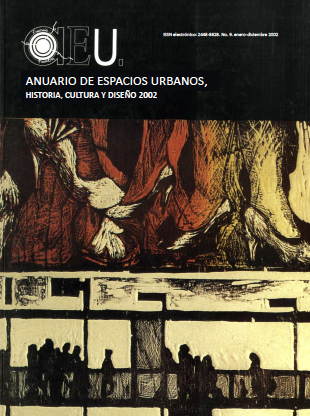Archives
-

Anuario de Espacios Urbanos, Historia, Cultura y Diseño
No. 31 (2024)Con la presentación de este número 31, el Anuario de Espacios Urbanos, Historia, Cultura y Diseño (AEUHCD) inicia su cuarta década de vida consolidándose como una de las publicaciones académicas más sólidas de la División de Ciencias y Artes para el Diseño, de la Universidad Autónoma Metropolitana unidad Azcapotzalco. El Anuario de Espacios Urbanos, Historia, Cultura y Diseño (AEUHCD) ha sido un vehículo de gran relevancia para difundir las discusiones en torno a los fenómenos urbanos que nos interpelan como sociedad, cómo colectividades urbanas y como personas que atesoran sus particularidades individuales. En los treinta números que nos anteceden, ustedes pueden explorar una gran diversidad de artículos de investigación, ensayos, entrevistas, reseñas y reflexiones que dan testimonio del momento histórico por el que atraviesa la humanidad, caracterizado entre otros aspectos, por la creciente importancia de la vida urbana con respecto a otras formas de vida que no tienen como escenario las ciudades. El AEUHCD en sus páginas ha sido testigo de la transformación del mundo a través de la mirada y la pluma de investigadoras e investigadores, que nos han ayudado a entender el complejo engranaje que mantiene en movimiento a ese “gran vehículo del progreso” que requiere de grandes áreas metropolitanas para crecer y mantenerse vivo, poniendo a prueba nuestra relación con los territorios que le dan vida al planeta tierra, a pesar de las graves consecuencias que pueda haber para la biosfera o los entramados sociales. Durante las tres décadas de existencia del AEUHCD, está publicación académica ha sido impresa, los treinta números anteriores se han distribuido físicamente en ferias de libros, librerías universitarias, donaciones a otras instituciones educativas o mediante la repartición de los ejemplares con las autores y autoras que han escrito los textos que le dan vida a estas miles de páginas publicadas. Este número treinta y uno del AEUHCD, junto con el próximo que será el treinta y dos, son probablemente los últimos que veremos impresos en papel, estamos atravesando un periodo de transición en el Área de Estudios Urbanos de la UAM Azcapotzalco, y en general en las dinámicas de difusión del conocimiento, que ponen en primer lugar de los debates, la necesidad de migrar a formatos completamente digitales y gratuitos con los cuales, una publicación como esta, pueda cumplir su función social de manera más eficiente y dinámica, teniendo coherencia con los flujos de información que vivimos en 2024 y las exigencias de las principales indexaciones científicas que nos evalúan. Por tanto, disfruten especialmente este número quienes tengan la oportunidad de leerlo en su versión impresa, disfruten el olor a tinta pues tiene aroma a cambio en nuestra humilde historia dentro de los estudios urbanos. El presente número del AEUHCD se compone de tres artículos de investigación, un ensayo, una reseña y una nota crítica. En el artículo titulado "Gestión integral de diseño hacia la mitigación del riesgo en la ciudad inundable," Jorge López Ortiz y Rubí Elina Ruíz y Sabido abordan los impactos de los fenómenos hidrometeorológicos en las ciudades, con un enfoque particular en Mérida, Yucatán. La autora y el autor proponen un modelo integral para la prevención de riesgos urbanos que considera el desarrollo urbano y la vulnerabilidad, el calentamiento global relacionado con la actividad humana, una crítica a los modelos actuales de gestión de riesgos centrados en la contingencia y la adaptación, la topografía específica de Mérida y el uso adecuado de la cartografía para la identificación de riesgos. Este artículo sugiere que, mediante el análisis de estos aspectos y con el trabajo conjunto de la comunidad, se puede influir en la mejora de las políticas públicas de prevención de riesgos dentro del ordenamiento territorial. En el artículo "Causas de muertes en la Zona Metropolitana de Monterrey" Luisa Damiana Páez de González, María de Jesús Ávila Sánchez y José Juan Cervantes Niño analizan las causas de fallecimientos en los municipios que conforman la Zona Metropolitana de Monterrey (ZMM) para proponer mecanismos urbanos que reduzcan el riesgo de desastres y fortalezcan la resiliencia de la ciudad. Este estudio cuantitativo, de análisis retrospectivo no experimental y transversal, se basa en datos de defunciones en el estado de Nuevo León y la ZMM entre 2019 y 2021, extraídos de la Secretaría de Salud y el Instituto Nacional de Geografía e Informática (INEGI). Este artículo presenta resultados que indican que la principal causa de muerte en la ZMM son los accidentes de tránsito, especialmente entre hombres en edad productiva que carecen de una cultura vial adecuada. A pesar de los mecanismos existentes para reducir estas muertes, los resultados no han sido efectivos, subrayando la necesidad de desarrollar y promover nuevas estrategias de prevención. Alejandra Trejo Poo coloca en el centro del análisis a la oscuridad urbana en su artículo “Oscuridad que ilumina. Intervención artística nocturna con El Clan de la Noche en Tlaltenco, Tláhuac, Ciudad de México”. Aquí se relata como en el contexto del Taller-Laboratorio de prácticas y experiencias nocturnas en Tláhuac, se formó la comunidad "El Clan de la Noche", que, a través de la intervención artística y el trabajo colaborativo, exploró nuevas formas de habitar la noche urbana y su oscuridad. A pesar de la omnipresente contaminación lumínica que caracteriza a la mayor parte de la CDMX, la intervención artística realizada por "El Clan de la Noche" en “La Ciénega” cercana a Tlaltenco, Tláhuac, demostró que es posible redefinir el significado de la noche, promoviendo una interacción sensorial y colectiva que deconstruye prejuicios y transforma espacios inicialmente desconcertantes en escenarios de creación y encuentro. Este artículo examina cómo la oscuridad puede impulsar la creación de comunidades y resignificar la experiencia nocturna urbana, destacando la importancia de integrar la penumbra en la vida urbana para fomentar una relación más rica y diversa con nuestro entorno. En el ensayo titulado "Financiarización en las ciudades: apropiación presente del futuro", Enrique Soto Alva analiza cómo la financiarización ha transformado las ciudades y el impacto de estos cambios en el espacio urbano y social. El ensayo subraya la necesidad de comprender la financiarización para poder analizar y mitigar sus efectos en las ciudades, sugiriendo que la transformación financiera ha llevado a un nuevo orden económico que impacta profundamente en la vida urbana. Se comenta el origen y concepto de financiarización, su efecto en la transformación de las ciudades propiciando entornos favorables para las grandes finanzas, pero desfavorables para las comunidades humanas, se explica cómo el modelo de capitalismo fordista, basado en la producción real, se ha transformado hacia un sistema de acumulación basado en las finanzas. A través de este ensayo se comprende como la financiarización ha llevado a la creación de personas, empresas y gobiernos endeudados, afectando la economía doméstica y el acceso a servicios básicos como la educación. Jasmin Anavel Monterrubio Redonda realiza una reseña sobre el libro “La producción de la ciudad latinoamericana durante el neoliberalismo” que compiló Emilio Pradilla, publicado en 2023 por la Universidad Autónoma Metropolitana. Esta reseña aborda cómo las ciudades latinoamericanas han sido transformadas por el neoliberalismo. A partir de un enfoque crítico y marxista, el libro reseñado examina las dinámicas de urbanización, la influencia del capital inmobiliario-financiero y el papel del Estado en la reproducción de lo urbano. A través de 19 capítulos escritos por diversos autores y autoras, se analiza cómo el neoliberalismo ha reconfigurado las estructuras sociales y espaciales de las ciudades, creando nuevas formas de desigualdad y exclusión. Los autores y autoras también exploran la pertinencia de las teorías neoliberales y proponen alternativas basadas en la realidad latinoamericana, destacando la importancia de desarrollar teorías y prácticas urbanas que respondan a las necesidades específicas de la región La nota crítica de Fernando Barona Garduño titulada "¿Desvinculación o decrecimiento? Un marco analítico para abordar la transición socioecológica desde los estudios urbanos" plantea una discusión crítica sobre la transición socioecológica y su relevancia para una nueva agenda urbana. A través de las perspectivas de la desvinculación económica, que confía en el desarrollo tecnológico y el mercado, y el decrecimiento, que aboga por una reducción equitativa de los estándares de vida y la descentralización urbana, el autor explora cómo los estudios urbanos pueden contribuir a entender y gestionar los flujos de materia y energía en las ciudades. El artículo destaca la importancia de superar los límites del crecimiento capitalista para avanzar hacia una sociedad sustentable y aborda las contradicciones inherentes a la búsqueda de un "capitalismo verde". La obra gráfica expuesta en las páginas de este número 31 del Anuario de Espacios Urbanos, Historia, Cultura y Diseño, es autoría de la diseñadora Valeria Ximena Cañedo Cortes. Se trata de una serie de imágenes titulada “nostalgia urbana”, en la cual se registran escenas de murales pintados sobre la base de las columnas que sostienen la estructura de la línea 4 del metro, que pueden observarse al transitar la avenida Congreso de la Unión de la CDMX, artería por la cual comúnmente transita Valeria Cañedo. Esta serie no solo destaca la importancia de los murales como narradores de nuestra historia mexicana, sino también el impacto emocional y simbólico que los colores pueden tener en nuestra percepción y conexión con el arte urbano. Las fotografías, presentadas en escala de grises con predominancia del color azul, buscan evocar sentimientos de calma, paz, y especialmente nostalgia y melancolía, reflejando la historia y el significado profundo que evoca esta zona de la ciudad para quienes la habitan desde la perspectiva de la diseñadora. Esta obra gráfica fue seleccionada entre muchas otras series de imágenes, que participaron en la convocatoria del Dossier Gráfico del AEUHCD que tuvo como temática general “EL COLOR EN LO URBANO”. La temática se justificó entendiendo que el color es un elemento que puede darle identidad a una zona urbana, la cual puede ser compartida en forma de opinión generalizada por una parte de la población que habita en ese lugar. El color es una dimensión fundamental en la vida urbana que influye en nuestra percepción del espacio, nuestras emociones y nuestra interacción con el entorno construido.No queda más que agradecer su presencia y su lectura, invitándoles a disfrutar este trayecto, el número 31 del Anuario de Espacios Urbanos, Historia, Cultura y Diseño -

Anuario de Espacios Urbanos, Historia, Cultura y Diseño
No. 30 (2023)From the anniversary. On this occasion we offer the academic community number 30 of the magazine. The Yearbook of Urban Spaces, History, Culture and Design (AEUHCD) has been the result of three decades of continuous work whose direction has fallen on the members of the Urban Studies Area, who in turn have assumed that responsibility. Throughout these years we can scrutinize the purposes that gave rise to it, the generational changes and the seal that each editorial coordination has left on it. However, the magazine maintains its interdisciplinary spirit; Each of its issues reflects the discussion and updating of problems around the city from different perspectives. From the graph. For 30 years at the AEUHCD we have allocated the spaces on the cover andsome interior sections to display the graphic work of artists with different origins. However, as part of the changes, which we began in 2020, we have decided to more forcefully promote graphic collaborations accompanied by a reflection on the selected work. In the Yearbook, the visual arts have had a space to rethink the city with all its complexity. The use of artistic practices as a research methodology opens new possibilities for understanding urban phenomena from a transdisciplinary perspective. About the number 30 and urban studies. Due to its commemorative nature, this issue includes some works that aim to contribute to a permanent reflection on the issue of urban studies and that provide continuity to other texts that have appeared in the Yearbook: “A review of the main theoretical currents on the urban analysis” by Tamayo (1994); 20 years later “From socio-territorial justice to spatial justice” by Ejea (2013); In number 22, Morales (2015) questions “What are Urban Studies? A definition of the field of study, brief history, some key themes and perspectives.” Added to the above is the interview with Sergio Tamayo published in issue 27 (2020) in which he recounts the motivations for building an academic project with three aspects: Area, Magazine and Postgraduate in Urban Studies. Number 30 is made up of five articles, a methodological note, three reviews, two interviews and a graphic series. Articles. In “Decoupling or degrowth? An analytical framework to address the socioecological transition from urban studies” Jerónimo Aurelio Díaz Marielle addresses social inaction in the face of climate change. Throughout the article, it examines some emerging concepts that serve to understand the problem of the global environmental crisis and climate change in the context of urban studies. It weaves different axes of conceptual analysis linked to social sciences, planning and urban design.In “Urban imaginaries in current metropolitan areas: the case of Texcoco de Mora, located in the Metropolitan Zone of the Valley of Mexico (ZMVM)” Manuel López states that cities and the metropolitan areas that surround them are not homogeneous spaces, consequently , urban imaginaries are not either. In fact, this heterogeneity hints at differences and oppositions towards hegemonic imaginaries. To demonstrate the above, he examines the case of the People's Front in Defense of the Land and its confrontation with the construction of the New International Airport in Mexico City.Jorge Alberto Juárez Flores and Thiany Torres Pelenco in “Uninhabited housing in the Metropolitan Area of Toluca: an approach from urban complexes” address the reasons that lead to this phenomenon. In their work they warn that uninhabitation has one of its causes in the implementation of housing policies that it produces without taking into account the needs of the population to which it will be directed. The action of the State has been diminished and the interests of real estate companies take precedence over the common good. The consequences are diverse on the territory: social and spatial fragmentation. The article concludes with a set of proposals for the State to recover its leading role to promote instruments that regulate housing policies.Érick Serna Luna in his article “From transportation to the plaza. “Urban development in Azcapotzalco and the renovation of CETRAM El Rosario” explains that the construction of equipment is not a guarantee to transform or eradicate some social practices. Through a historical and ethnographic analysis of this area, it shows how the intersection of economic development policies with transportation policies has led to the construction of shopping plazas that replace bus stops, the latter associated with informal commerce, dirt and backwardness. The author highlights that the rhythms of urban development do not always coincide with the social dynamics in space. That is to say, although the space is transformed by the construction of large facilities, the logic of urban practices advances at different rates.Jorge López Ortiz and José Antonio Morales Cruz in their article “Bibliometric analysis of public space and the management of social emergencies” review the state of the art regarding research on the relationship of public space to social emergencies caused by threats. such as natural disasters or health emergencies with a bibliometric methodology. The results of this review showed that there is a lack of specific studies on risk and emergency management for public spaces. The authors raise the need to offer a state of the art regarding public space and social emergencies to identify global trends in academic and scientific production over a period of 15 years regarding these topics. Methodological notes. Berenice Ortiz Barajas and Clara Sugeydy Torres Uicab in “Living from a gender perspective: the street and women, Chetumal, Mexico” examine the perception of urban public safety through the eyes of women. In this case study, various methodological tools are used to examine public space, which allowed the authors to confirm that the use of space is conditioned by gender roles. Reviews. Blanca Rebeca Ramírez Velázquez offers the valuable testimony that accounts for a publication of great notoriety. In “A tribute for a legacy to urban knowledge: Ciudades magazine” the author recounts this publication that between 1989 and 2018 published 120 issues;analyzes the impact and contributions of the journal in the field of urban studies. The magazine was the result of the conjunction of the work of the Politics and City Seminar coordinated in its beginnings by Pablo González Casanova and the National Urban Research Network (RNIU). It also examines the contributions that the magazine offered internationally and the reasons that led to its disappearance.In “Latin American urban history: a discipline in revitalization,” Carlos Bustamante López offers a review of some of the recently published works on urban history. In “30 years of the Yearbook of Urban Spaces, History, Culture and Design” Francisco Javier de la Torre Galindo and María Esther Sánchez Martínez present a quantitative analysis of all the published works from a critical perspective. The exam reflects these changes in the timeline through graphs and also shows some of the challenges that the Yearbook faces. Interview. María Esther Sánchez Martínez and María del Carmen Bernárdez de la Granja offer the interview with Ariel Rodríguez Kuri regarding the 30 years of the Yearbook and the Urban Studies Area. There Rodríguez reviews the founding of these projects and the relevance of urban history.As part of the connection between academia and society, “The socio-environmental crisis in the Alto Atoyac River Basin: meeting with María de Lourdes Hernández Rodríguez” shows an interview conducted on three axes: the description of the Alto Atoyac basin; ecological problems; and the alternative solutions, the authorship is Francisco Javier de la Torre and María Esther Sánchez Martínez. From the work of “ZeCarrillo”. The graphic proposal that we see on the cover and the interiors of this issue was in charge of the Colombian artist and designer Carlos Andrés Carrillo “ZeCarrillo”. His work is divided into seven powerful images; There he expresses the discussion between high culture and popular culture. That is, it exhibits the symbolic distance that exists between the works of art that we can see in large museums and the artistic expressions that are born organically from urban life. It was made with fragments of images found in random walks through streets, facades and street stalls in Colombia. The work that “ZeCarrillo” offers is a dignification of Latin American visual culture, a humorous gesture that distances us from the domestication of the gaze from a Western hegemonic perspective. We find all this in commercial signs, handmade fonts, popular phrases and portraits of passers-by. The artistic proposal presented in these pages is an invitation to the democratization of art with humility; a recognition of the value of the diversity of identities in Latin America; an exercise in visual ethnography to not forget the living art that exists in the streets and refuses to disappear. María Esther Sánchez MartínezFrancisco Javier de la Torre GalindoDaniel Fajardo MontañoMexico City -

Anuario de Espacios Urbanos, Historia, Cultura y Diseño
No. 29 (2022)Between 2016 and 2017, the most recent reform of the Mexican capital materialized. Specifically, on January 29, 2016, the adjustments to the Political Constitution of the United Mexican States regarding the Political Reform of Mexico City were published, which allowed, as of September of that year, the establishment of the Constituent Assembly, body that would approve the Political Constitution of Mexico City on January 31, 2017, published on February 5 in the Official Gazette of the city government. This fact is loaded with a political-cultural history that goes back at least four decades. During the eighties –the so-called lost decade–, the tensions between different citizen groups and the (federal-local) government that had been expressed since 1968 unfolded. These increased since the 1985 earthquakes and the 1988 elections, and led to in the local political scene to the articulation of some of the left in a new political party, as well as the formation of the Assembly of Representatives of the Federal District (ARDF) as the first body of local representation (1988-1997). The ARDF promulgated in 1994 the first Government Statute of the Federal District. Three years later, in 1997, the ARDF became the Legislative Assembly of the Federal District (ALDF) (1997-2018) and the first elections for Head of Government of the Federal District were held -erased since the promulgation of the Organic Law of the District and the Federal Territories of 1928-. With the Political Constitution of Mexico City (CPCDMX), the ALDF gave up its place to the Congress of Mexico City in 2018. Thus, the local Constitution represented the vanguard point in a process of complex, conflictive and, at times, change, contradictory for the Mexican capital. During this reform journey, the city went from 8,831,079 inhabitants in 1980 to 9,209,944 in 2020, a relatively low rate that contrasts with the growth in housing that will go from 1,754,727 to 2,756,319. At the metropolitan level, the territorial extension of urbanization went from 61,000 to 235,000 hectares, and the population will jump from 14.2 million inhabitants in 1980 to 21.8 million in 2020. This urbanization process was structured unevenly, which strengthened segregation in the capital, with a population in a situation of poverty that is accentuated (30% and another 36% in vulnerability due to income or social deprivations) (Coneval, 2018), in addition to the increase in the perception of insecurity (ENSU- INEGI). Despite the outsourcing of the city, the environmental issue continued to be critical; the management of water and waste without solution; power consumption increased; that is to say, a collapse scenario that contrasts with the rise of financial real estate capital in the production of the city. Given this context –and despite the fact that the time elapsed of the most recent regulatory framework of the city is short–, this issue of the Yearbook of Urban Spaces deems it relevant to stop along the way to reflect from different points of view on the principles and mandates of the Political Constitution of Mexico City and evaluate what their effects have been on the urban reality. The articles that make up the dossier: "5 YEARS AFTER THE POLITICAL CONSTITUTION OF MEXICO CITY" offer a reflective and analytical overview of some of its effects, impacts and imprints in its first five years through three thematic axes: the Constitution and human rights in the city, the challenges of the city from the Constitution and the Constitution and the planning of the city. The first article by Guillermo Ejea Mendoza, "Constitution, inequality and territorial imbalance", analyzes the incidence of the Political Constitution of Mexico City in the structural transformation of the capital. Based on the review of various documents and the projects of the Institute for Democratic and Prospective Planning, it underlines the relative change in the way of conceiving urban development with respect to previous governments. In this sense, the state power has resumed driving so as not to leave everything to the market, despite this, the impulse to social, economic and urban development has focused on central and consolidated areas. Consequently, the author points out, it is contradictory that, as in previous years, the same areas are excluded from this new model of urban development. What is missing in any case is to fulfill these new ideals and ensure that social and economic justice are linked to territorial justice. In "Multicultural City: Limits and scope of the recognition of rights in the native peoples of Mexico City in the local constitution, secondary laws and government acts", Martha Angélica Olivares Díaz and Alejandro Velázquez Zúñiga examine the challenges and obstacles that they have had to confront the original towns and neighborhoods, particularly in the mayor's office of Xochimilco. One of the central problems, say the authors, lies in the formulation of secondary laws that result in ignorance of cultural diversity. However, the original peoples manage to advance in their demands despite the power of the State. Despite its recent creation, the Institute for Democratic and Prospective Planning of Mexico City has had to face some dilemmas “in order to make planning an exercise legitimately democratic. In this sense goes the analysis of the article by Jasmin Anavel Monterrubio Redonda in "Dilemmas of the Institute of Democratic and Prospective Planning of Mexico City for the democratization of the city planning process". The author maintains that for its operation some variables must be considered: management, the organization of the teams to attend to the different actors and the definition of other participatory scenarios. Despite this, it seems that the Institute was created only to comply with the administrative issue rather than to seek a true transformation. Miguel Ángel Ramírez Zaragoza in “The right to the city in Mexico City. From the letter to the Constitution: 2007-2017” raises the relevance of the Charter of Mexico City for the Right to the City and its inclusion in the Political Constitution of Mexico City. It highlights the importance of social participation as the articulating axis to assert this right. But despite having created the Institute for Democratic and Prospective Planning, adequate strategies have not been drawn up to promote the full exercise of the right to the city. Juana Martínez Reséndiz in “Urban development and right to care in the Political Constitution of Mexico City. Contributions for your discussion” examines the problems that women face in care activities in the context of urban development. It exposes the need to modify the approach regarding domestic and care work assigned only to women, which are unpaid activities. The objective is for this to acquire a legislative dimension and for Mexico City to become a city of care. In the Research Articles section on the urban phenomenon, two contributions focus on the methodological dimension. On the one hand, Giovanni Marlon Montes Mata and Rafael Monroy Ortiz, in the text "Among urban fecal stenches, misery and intestinal diseases in Cuernavaca", analyze the underdeveloped urban structure of the city of Cuernavaca which discharges wastewater without mediating treatment to the ravines. In particular, they examine the correspondence between poverty, intestinal diseases and contaminated wastewater. They expose the way in which sanitation has been conceived and its link with environmental deterioration and the health of the inhabitants. The authors conclude that solving the problem would bring fiscal, environmental and public health benefits. On the other hand, Christof Göbel and Elizabeth Espinosa Dorantes in "Reasons for walking in the center and periphery of Mexico City (CDMX)" propose that the location of the spaces and the perception of these affect the users. They offer three case studies: the subdivision of Sayavedra County and the popular neighborhood El Molinito, which will be compared with the Madero pedestrian corridor in the Historic Center of Mexico City. In their work they conclude that the location, the valuation of the public space and the perception of the territory condition the possibility of carrying out a pedestrian route. The Publication Reviews section offers two book reviews that offer a critical look at the most recent urban reproduction processes. In the first place, Blanca Rebeca Ramírez Velázquez makes a detailed review of the work “Multiteritorialidades del Neoliberalismo. Experiences in Mexico City” coordinated by Carmen Valverde, Luliana López Levi and Carla Filipe Narciso. Immediately, Lisett Márquez López does the same with the book “City in dispute. Urban policy, citizen mobilization and new urban inequalities”, coordinated by Francisco Javier de la Torre Galindo and Blanca Rebeca Ramírez Velázquez. The issue closes with the special Interview that the editorial coordinators of the AEUHCD held with Enrique Ortiz Flores, a leader in social struggles for socio-spatial justice in Mexico, Latin America and the world. The meeting with Enrique Ortiz provides reflective, critical and propositional elements on the challenges and possibilities of the Political Constitution of Mexico City. María Esther Sánchez Martínez Francisco Javier de la Torre Galindo -
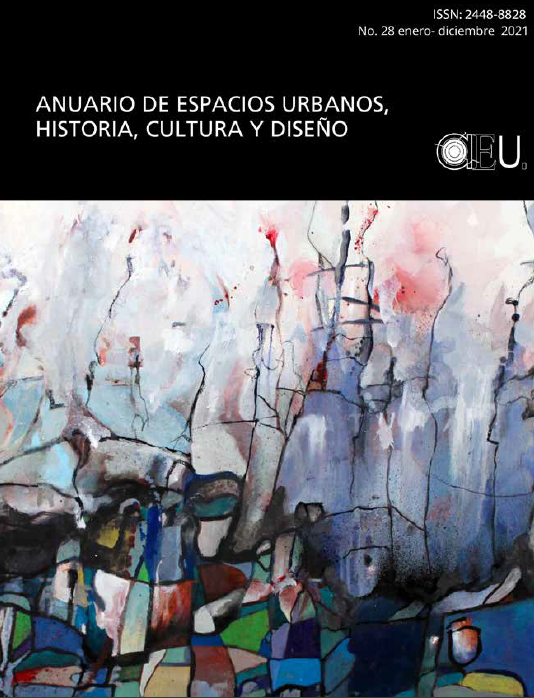
Anuario de Espacios Urbanos, Historia, Cultura y Diseño
No. 28 (2021)Since its detection in Wuhan, China, at the end of 2019 and its naming by the World Health Organization as the new coronavirus Covid-19 on February 11, 2020, the pandemic has become the latest global crisis that keeps the planet at a complex crossroads. National and local governments implemented various restrictive responses to circulation, which had an impact on economic activities and social relations. At the close of the same year, the news about the appearance of vaccines made it possible to imagine a different 2021. Vaccination began and spread throughout the world, reducing the lethality of the pandemic. However, the cases continued to rise and the inequality in the distribution and application of the vaccines was evident on a regional scale. In this crisis, cities, as centers of concentration of population and activities, have faced a tension between prioritizing the care of their inhabitants, addressing the economic crisis or reactivating flows and adjusting physical structures for the so-called new normality. But the structuring inequality of the urban space (fragmentation, overcrowding, segregation, displacements, evictions, etc.) is not a consequence of this situation, although it has become exponential. Thus, the discussions on the urban have come and gone between the conjunctural and the structural, that is, between the need to concentrate the effort in overcoming the moment or, instead, continue with the reading of the impacts as a consequence of the historical condition of production of the city as a materialization of the phases of capitalism. This issue recognizes a position towards the second approach: the structural one. Three dimensions support this approach. The first refers to the permanent dispute between the dynamics of reproduction of urbanization, the aspirations to control and plan it, and the growing needs of a population with a strong popular base. The second has to do with the relationship between the State and real estate capital from the paradigm of modernity or modernization processes. From this dimension, the change of position and prominence of the sectors is of interest, as well as the development of an ideological form of reproduction of the urban space that adapts to the conditions of each territory and that reinvents itself with each crisis. The third is dialectically relevant because it is made up of the social-urban mobilization, its imprints, resistances and transformation projects, as well as its struggle for permanence. Based on these three dimensions, the research articles support the understanding of the preeminence of real estate capital in the adaptation of the institutional public structure, and the distance of the governmental apparatus from the practices of spatial justice and the right to the city. The result is the development of inequality, but also of the dispute over the city from various fronts. The first text offered is “The Mixed Planning Commission. A key organism in the urban planning of Mexico City during the regency of Ernesto P. Uruchurtu, 1952-1966” by Carlota Zenteno Martínez who analyzes the urban transformations of Mexico City during the period of the iron regent from the Perspective of the Mixed Planning Commission. One of the contributions of the text is aimed at demystifying the figure of Uruchurtu as the central character from whom all the initiatives and works emanated to materialize the urban projects carried out in the mentioned period. For this, it analyzes the role that the Mixed Commission had in the management of the projects, all of the above endorsed by a legal and administrative structure. With this, it intends to examine the discussions and oppositions that arose during this period of transformation. Silvia Roca and Micaela López present us with an article called “Real Estate Commodification of Natural Assets: Differentiated Urban Development in North Patagonia. The case of the city of Neuquén, Argentina” where they explore the urbanization patterns carried out by large developer companies in exclusive urban environments. In this text we will find an analysis, from the perspective of environmental justice, of socio-residential segregation from the endowment of green spaces. The authors examine the cases of two areas that account for the different valuation and pattern of urbanization based on environmental distinctions in the city of Neuquén. On the one hand, there is that area with an important and careful endowment of green spaces and, on the other, the area of desert landscape made up of popular neighborhoods that grow without defined patterns, relegated to the periphery and with a deficient endowment of urban services. . In this city, regulations have been drawn up that promote "sustainable, planned, participatory and inclusive urban development", despite this, the reality is contradictory in the framework of resilient cities. As the authors point out, resilience will have to be observed within the framework of power relations. "Territorialization, poverty and the emergence of multiple territorialities in the peri-urban area of Morelia, Mexico" by Ana Isabel Moreno Calles, Yadira Mireya Méndez Lemus and Abelardo Renward Pérez Monroy explore the fragmentation of the La Aldea territory based on the excessive construction of divided rooms and equipment of consumption, which more than benefit the population in general, pay off for large investors. This analysis identifies spatial processes that have to do with the consolidation of a poor peasant territory, industrialization as a palliative of poverty. At the same time, the above reveals the historical-spatial dynamics and the survival of poverty, where the different social actors are configuring their environment based on their own needs, work and their political and socioeconomic context. “The role of the State and real estate activity in the modernization of two Latin American cities: Mexico City and Lima” by Erika Angélica Alcantar García and Jéssica Esquivel Coronado is a comparative analysis of two real estate developments in two different countries during the same period of time. . The text explores the parallels of real estate activity and shows that urban land speculation not only benefits big capital but also certain social groups. On the other hand, 2021 was also resented by the urban studies community due to the departure of some of its references. This number offers a collective text as a tribute to one of them: Rene Coulomb. Finally, the Yearbook ends with Francisco de la Torre Galindo's review of the book El Centro Histórico turistificado by David Navarrete, the text brings us closer to the analysis of gentrification processes. Francisco Javier de la Torre Galindo María Esther Sánchez Martínez -
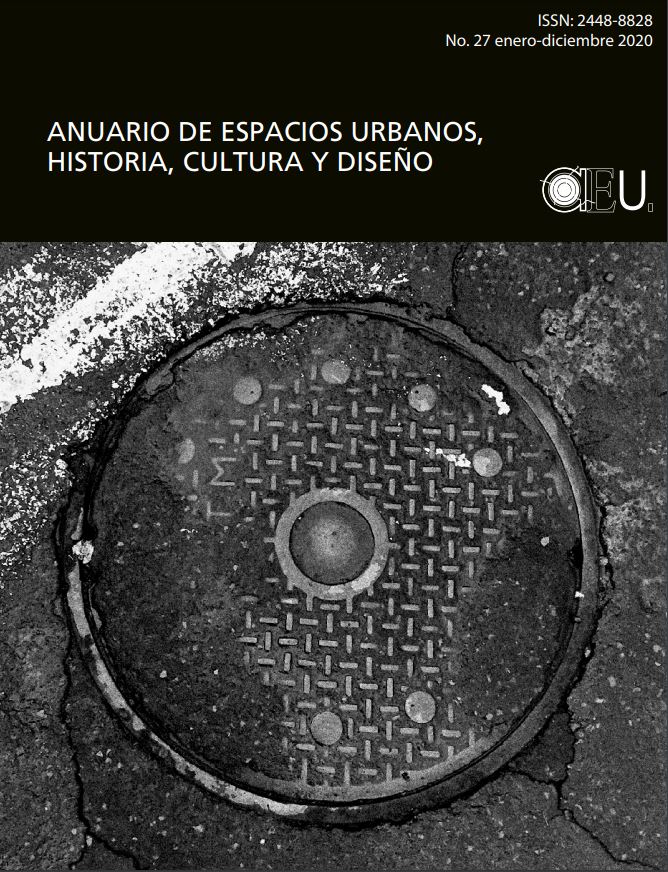
Yearbook of Urban Spaces, History, Culture and Design
No. 27 (2020)The growth of cities and the consequent difficulties and challenges that their inhabitants face every day has led to a wide spectrum of approaches for reflection on a pressing issue: the metropolis. Research on the subject has become, in an obligatory way, interdisciplinary; the conjunction of various angles enables a broad understanding and a more complex analysis of the new cities. Cities have become territories of great spatial, demographic, political, cultural and economic relevance; According to the United Nations Organization, currently fifty-five percent of the people in the world live in cities. His study, however, leads us to focus or particularize the analysis to aspire, perhaps, to an understanding of what happens in these large population agglomerations. In the cities poverty and wealth coexist; violence, insecurity and, also, sophisticated health, education, supply, communication facilities and monumental architectural feats, as well as large infrastructures. It is a priority, therefore, to think of cities from new points of view that favor their spaces, inhabitants and the environment. Cities are living entities, their changes often erupt randomly, becoming uncontrollable challenges. -
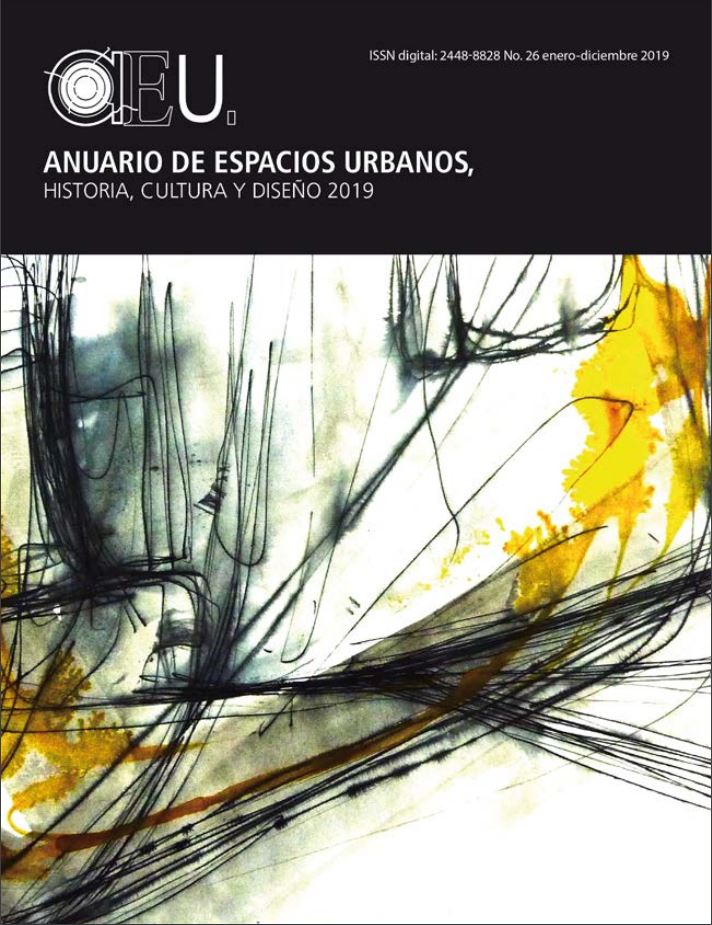
Anuario de Espacios Urbanos, Historia, Cultura y Diseño
No. 26 (2019)The city is a complex construct that includes the tangible as well as the intangible geography, product of the socioeconomic, political and cultural relations that occur within it, defining its historical evolution, transforming its morphology and its very definition as a space. As such, the study of Urban Space implies the conjunction of several areas of knowledge (with their respective methodologies and tools) that, intertwined, try to define and analyze this time-varying construct. Two crucial aspects in the understanding of the urban are the morphology and habitability of space (in its most inclusive meaning). One, because it analytically describes the production and evolution of the urban form, derived from its built elements, transformations, interrelationships and the social processes that involve them, defining and explaining the urban landscape and its structure; and the other, because it diagnoses and correlates the factors and processes (environmental, political, socioeconomic, etc.) that influence the quality of life within the urban space, to establish concrete actions and policies to anticipate and correct vulnerabilities – present or future. – that hang over the quality of life. -

Anuario de Espacios Urbanos, Historia, Cultura y Diseño
No. 25 (2018)In this presentation of the twenty-fifth Anuario de Espacios Urbanos, corresponding to 2018, we reflect on the theoretical discussions on the concept of urban space with which we have contributed to this publication in the last quarter of a century. This review, in addition to reviving old confrontations, will help us locate the conceptual approaches that the ten works included in this issue propose to us. -
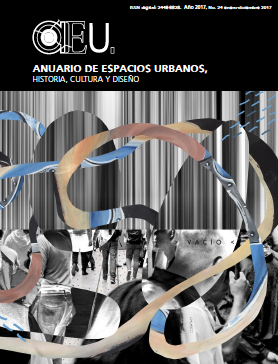
Anuario de Espacios Urbanos, Historia, Cultura y Diseño
No. 24 (2017)One of the fundamental tasks of the Urban Studies Research Area has been the generation of open academic discussions and innovative research, one of the fundamental axes of which has been and is the Urban Spaces Yearbook. History, Culture and Design 2017, which on this occasion presents articles by academics from Mexico and Latin America, and which consolidates the 24 years of effort with the incorporation of the magazine to LATINDEX, under the coordination of Mtra. Consuelo Córdoba. Through its sections of Space, History and Identities and Culture, we intend to offer guides, lines and paths to test our certainties and subjectivities about the urban world where we live, and to leave open the discussion about these new paths. -
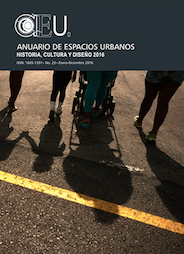
Anuario de Espacios Urbanos, Historia, Cultura y Diseño
No. 23 (2016)The city is not only a material structure in which a spatial organization of society is circumscribed through its buildings and institutions, it is a human production resulting from multiple interactions (Lefèbvre, 1969), therefore, it becomes a complex space. in which its dynamism means that its approach and study involves multi, inter and transdisciplinarity. These new approaches are a source of interest for the research presented in the 2016 Urban Spaces Yearbook in the three sections that compose it: “Urban space”, “Urban history and Identities” and “urban culture”. -
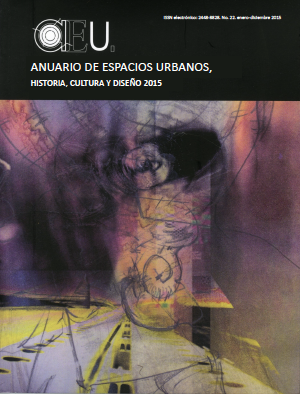
Anuario de Espacios Urbanos, Historia, Cultura y Diseño
No. 22 (2015)Everything that affects man affects the city. Therefore, studying cities requires an approach from multiple disciplinary and transdisciplinary approaches in the search for definitions, ideas and novel approaches. It is even necessary to rethink what was previously stated in the face of the dissimilar positions generated in the last two decades within studies on the city. This interest in reflection and discussion around the problems of cities is shown in the research published in the three sections that make up the 2015 Anuario de Espacios Urbanos: A perspective on urban studies, Urban space and Urban history. -

Anuario de Espacios Urbanos, Historia, Cultura y Diseño
No. 21 (2014)El área de Estudios Urbanos presenta esta edición del Anuario de Espacios Urbanos 2014, debido a que representa no sólo veintiún años de publicación periódica ininterrumpida, sino porque tambi´én constata el compromiso, el esfuerzo y el trabajo de cada uno de sus miembros; algunos han tomado distintos, pero los recordamos con cariño y reconocemos su valiosa aportación. Dicho compromiso, desde una aproximación multidisciplinaria que relaciona diversas perspectivas relativas al estudio de la ciudad como objeto y escenario, ha permitido hasta ahora generar un trabajo colectivo que contribuye al cumplimiento de los objetivos de nuestra Universidad: la investigación, la docencia y la preservación y difusión de la cultura, materializados en los diferentes números del Anuario de Espacios Urbanos y las tres secciones que lo conforman: "Espacio Urbano", "Historia Urbana" e "Identidades y Cultura Urbana". -
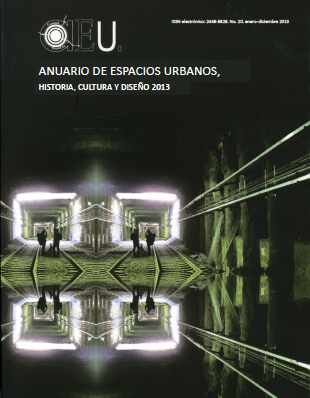
Anuario de Espacios Urbanos, Historia, Cultura y Diseño
No. 20 (2013)La ciudad es un espacio complejo, donde la interacción social construye formas y contenidos, originándose así lugares de intercambio y transformación. Dicho dinamismo ha convertido a la ciudad en un escenario de investigación idóneo, observada desde múltiples enfoques teóricos y metodológicos con objeto de definirla. Esta constante inquietud ha sido motivo de estudio de las investigaciones que, desde una visión interdisciplinaria de la problemática de las ciudades, presenta el Anuario de Espacios Urbanos 2013 en las tres secciones que lo integran: Espacio urbano, Historia urbana e Identidades y cultura urbana. -
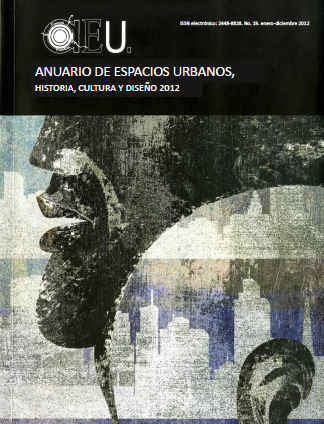
Anuario de Espacios Urbanos, Historia, Cultura y Diseño
No. 19 (2012)En las ciudades convergen diversos elementos; espacio y tiempo delimitan sus historias y los habitantes se convierten en los actores que las van conformando a partir de sus actividades, flujos y permanencias en los distintos escenarios, pero también pueden ser narradores e intérpretes ... ¿ Qué es hoy la ciudad para nosotros? Esta interrogante motivó las investigaciones que presenta el Anuario de Espacios Urbanos 2012, en las tres secciones que lo integran: Espacio urbano, Historia urbana e Identidades y cultura urbana. Los textos que lo componen incorporan una visión interdisciplinaria de la problemática de las ciudades, con distintas dimensiones: social, económica, formal, política, ambiental, histórica, etc., así como aquellas derivadas de su condición transversal y multidisciplinar. -
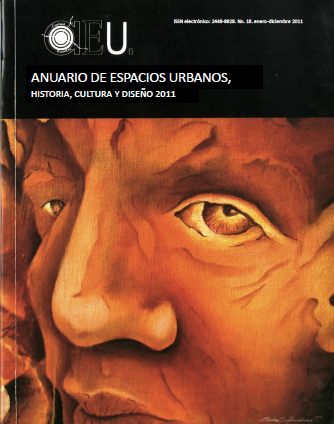
Anuario de Espacios Urbanos, Historia, Cultura y Diseño
No. 18 (2011)Over the last seventeen years, since the first publication of the Yearbook, the city has been the object of reflection. The various texts that have been compiled in previous versions are proof that the city is a dynamic and changing reality with form, organization, functioning and meaning, with variations according to the cycles and historical conjunctures; Therefore, it is a complex entity that must be approached from different disciplines and with different readings. The 2011 edition of the Urban Spaces Yearbook reaffirms this with the works presented in the three sections that comprise it: Urban Space, Urban History, and Urban Identities and Culture. -
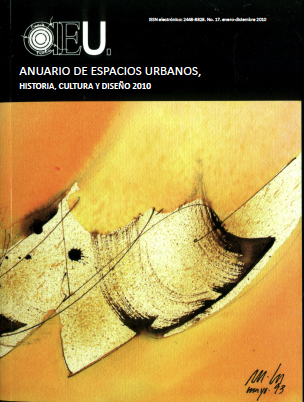
Anuario de Espacios Urbanos, Historia, Cultura y Diseño
No. 17 (2010)Para su presentación 2010, el Anuario de Estudios Urbanos decidió invitar a la mayoría de los investigadores que alguna vez editaron y coordinaron el anuario de espacios urbanos para celebrar la continuidad de este esfuerzo desarrollado a lo largo de los últimos dieciséis años. A todos aquellos que respondieron al llamado y a aquellos investigadores externos que participan en este número queremos agradecerles el haber hecho posible la consolidación de este espacio de discusión sobre el fenómeno urbano, donde tienen cabida todas las miradas que sobre la ciudad nos ayudan a entender la construcción de la polis. -
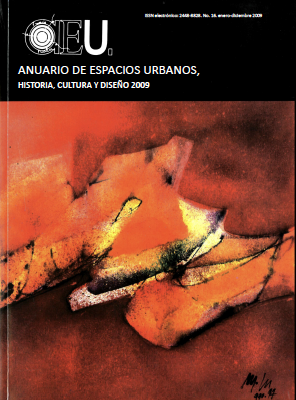
Anuario de Espacios Urbanos, Historia, Cultura y Diseño
No. 16 (2009)Sin duda, las historias de nuestros últimos anuarios no han estado exentas de desajustes de orden temporal que han afectado irremediablemente sus fechas de publicación. Este número, que estaba prácticamente listo desde hace un año, no será publicado sino hasta finales del 2010 o quizá a principios del 2011. Hay muchas razones que explican lo anterior, aunque no creo que valga la pena mencionarlas. Diré tan sólo que el Área de Investigación en Estudios Urbanos que la edita ha pasado por numerosas circunstancias que han afectado a la mayoría de sus miembros: quien no se fue de sabático simplemente se fue del área, quien no entró a un programa de doctorado o inició su tesis doctoral entró a coordinar nuevos programas académicos, y así hasta que lo sustantivo pasó a segundo término en espera de una nueva etapa que saque del atraso los materiales que tenemos preparados para su publicación. Este ha sido el caso del volumen 2009 de nuestro Anuario de Espacios Urbanos, una publicación que desde hace más de 15 años ha sido la mejor ventana pública de nuestras discusiones académicas en torno al tema de los Estudios Urbanos, y que este número da entera constancia de ello. Con las pertinentes mil disculpas que suplico al lector por el largo retraso en su aparición, a este número lo acompañan seis colaboraciones elaboradas por especialistas de indiscutible trayectoria académica, algunos ya reconocidos por la experiencia o el dominio del campo en el que escriben, y fueron clasificados en cuatro temas relevantes de nuestra especialidad: historia urbana, urbanismo, actores urbanos y otras perspectivas en la representación del espacio. -
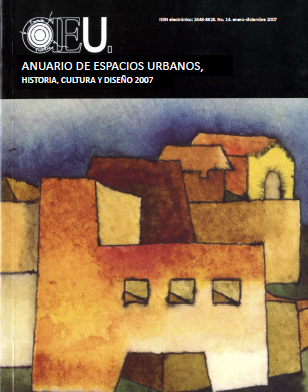
Anuario de Espacios Urbanos, Historia, Cultura y Diseño
No. 14 (2007)En el presente número del anuario hemos definido dos secciones, la primera referente a la discusión sobre el devenir de la vida cotidiana en la ciudad, sea esta México o Mexicali, partiendo de las perspectivas de la linguística, de la juventud callejera o del paisaje urbano. En la segunda sección se aborda el tema del uso social del espacio urbano que se perfila hoy, en las ciudades latinoamericanas, hacia la fragmentación social y la exclusión ciudadana. Concluimos con una reseña de Carmen Bernárdez sobre intervenciones urbanas y arquitectónicas significativas en Portugal. -
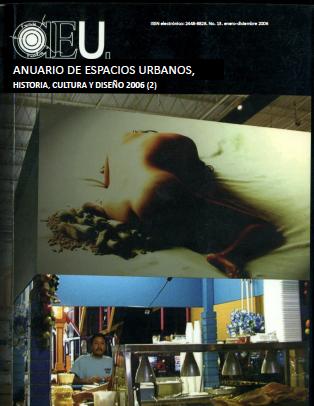
(2) Anuario de Espacios Urbanos, Historia, Cultura y Diseño
No. 13 (2006)La presente publicación tiene tres partes, una referida a la identidad urbana, otra a la planeación urbana y, finalmente, una última a las organizaciones sociales y migración. -
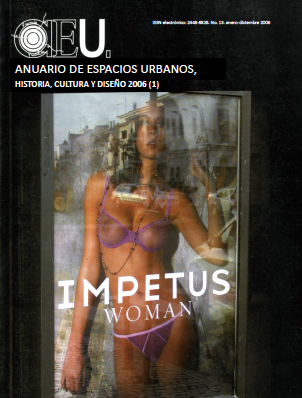
(1) Anuario de Espacios Urbanos, Historia, Cultura y Diseño
No. 13 (2006)El presente Anuario 2006-1, está estructurado en dos partes, cuyas temáticas tratan sobre concepción del espacio, historia urbana, planeación y sus órdenes metodológicos. -
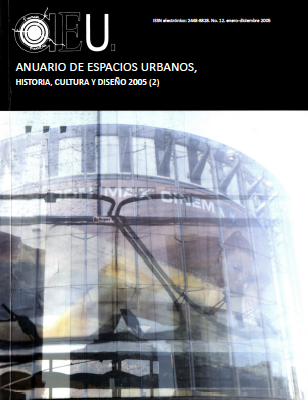
(2) Anuario de Espacios Urbanos, Historia, Cultura y Diseño
No. 12 (2005)En el presente anuario 2005-2, nuestra preocpación se centra en la discusión de las articulaciones del espacio urbano con lo subjetivo, la identidad y la planeación. La idea que la motiva es la concepción del significado de las expresiones culturales a partir de sus contenidos intencionales en el espacio urbano. -
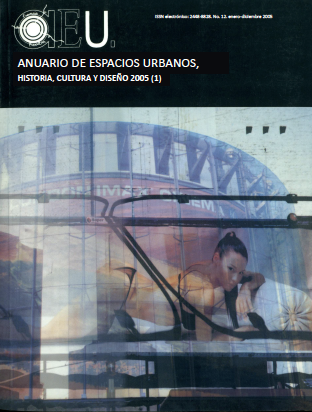
(1) Anuario de Espacios Urbanos, Historia, Cultura y Diseño
No. 12 (2005)La presente edición, parte I del Anuario 2005, da comienzo a una nueva dinámica en el Anuario de Espacios Urbanos del Departamento de Evaluación del Diseño en el Tiempo (CyAD, UAMA), pues, a fin de ofrecer un campo óptimo a las discusiones de los diferentes estudiosos de la ciudad, así como una mayor satisfacción a todos sus lectores, ahora el Anuario contiene dos subperíodos: parte 1 (invierno-primavera) y parte 11 (verano-otoño). En este volumen se han compilado temas referidos a investigaciones sobre la ciudad: su forma, su espacio, y sus actores sociales, resaltando el interés por la relación entre los hechos sociales y la morfología urbana. Estos trabajos, que de alguna manera denotan un lenguaje de la ciudad, se desarrollan desde diferentes enfoques, unos y otros entre métodos cualitativos y cuantitativos y entre diversas disciplinas, buscándose expresar elementos comunes basados en el significado de los hechos sociales dentro del espacio urbano. Una cuestión importante es saber cuál de estas expresiones tiene los vocablos más comunes, que permitan una comunicación interdisciplinaria grata. En mi opinión, de la que probablemente discrepen algunos de los autores de estos trabajos, solamente por medio de vocablos de la interactividad entre el hecho social y el hecho urbano arquitectónico se puede dialogar. -
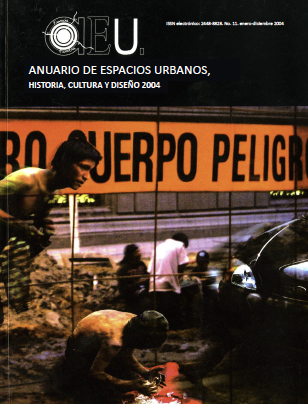
Anuario de Espacios Urbanos, Historia, Cultura y Diseño
No. 11 (2004)En esta ocasión hemos preparado un volumen con temas de gran interés para los Estudios Urbanos, esa emergente área de investigación que aborda el tema de la ciudad desde su propia complejidad (siempre múltiple, diversa y variable), problematizando aspectos de carácter cualitativo (historia, memoria, vida cotidiana, imagen del lugar, identidad) que permiten comprenderla como la proyección (o extensión) de sus propios habitantes, la materialización de su cultura y el laboratorio de formas sociales a las que acuden para apropiarse de un territorio y/u organizarse en el espacio. Aquí se toca, por ejemplo, uno de los temas favoritos de esta joven especialidad y que es el de la revisión crítica de la planificación urbana, ese verdadero sueño de la razón que ha producido más monstruos que paraísos, desmenuzado por diferentes acercamientos que subrayan la emergencia de otros actores y contextos (tercera edad, administración municipal, políticas culturales, multiculturalismo, paisaje urbano, corredores viales) de tal manera que, en su conjunto, ofrecen una mirada alternativa sobre la temática que orienta o promueven los ejercicios de la planeación. De ello dan constancia al menos la mitad de los diez artículos que lo componen (más una larga y bien documentada reseña). -
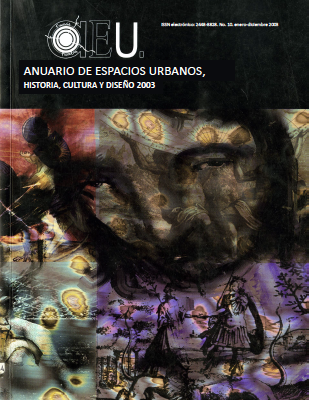
Anuario de Espacios Urbanos, Historia, Cultura y Diseño
No. 10 (2003)The Anuario de Espacios Urbanos, Historia, Cultura, Diseño celebrates a decade. The reader has in his hands issue number ten of a publication that has been, from the beginning, a committed academic and intellectual in exploring themes and methods for the study of the city and the urban. It is good to know that the Anuario was conceived by a group of researchers attached to a university design school, that is, to the Division of Sciences and Arts for Design of the Universidad Autónoma Metropolitana (Azcapotzalco). This news may be interesting. On the one hand, not all the founders of the Anuario have been architects or designers, but rather several of them come from the social sciences and humanities (sociologists, anthropologists, historians). Otherwise, however, architects and urban planners have permanently raised challenges in terms of the pertinent perspectives and the necessary methodologies in this academic practice, in such a way that the horizons of the publication have widened seen widened and questioned. There is not in sight a synthesis or a conclusion of what the Anuario has thrown into the intellectual life of the Universidad Autónoma Metropolitana and that of its own readers. In any case, a tangible result is the very possibility of maintaining for ten years a minimum intellectual (and university) consensus on the need for a publication organized around problems and research themes, and not around disciplines enunciated from the cold taxonomy of a manual of the International Labor Organization. For the rest, the Anuario was not conceived as a mode of expression only or mainly by the professors who founded it. On the contrary, the founders thought from the beginning that the Anuario was a publication offered to the academic community inside and outside the University. We made an offer, we created a space that was available to others. We only demand the minimum of quality and relevance, dictated by our experience and our knowledge.It is still a paradox that with all the budgetary and political disadvantages that the public university has today compared to private education, one of its bulwarks continues to be risk. As we all should know, research basic education, applied research, reflection and social criticism, and teaching that seeks to innovate by using the results of scientific and humanistic research are, all together and each one at the same time, risky companies. Beyond the planning exercises, and the order and concert to which we are all obliged in the management of public money, the tangible and measurable results of all these activities are not always predictable. The moment in which they will affect for the better the society and the culture from which they arise and to which they are due, is rather alien to the prophecies of planning, even though in the medium and long times their impacts will be visible to all. The Anuario has been a risk assumed for ten years by the Universidad Autónoma Metropolitana, with full awareness. Ideally, reading should also be a risk. Perhaps this is impossible in each issue and in each article, but we like to think that this should be the dominant trend in the relationship between the text and the reader. Reading as risk, the risk of reading. In the eight articles that make up this installment, the reader will know if it was worth it. Ariel Rodríguez KuriNovember 2003


